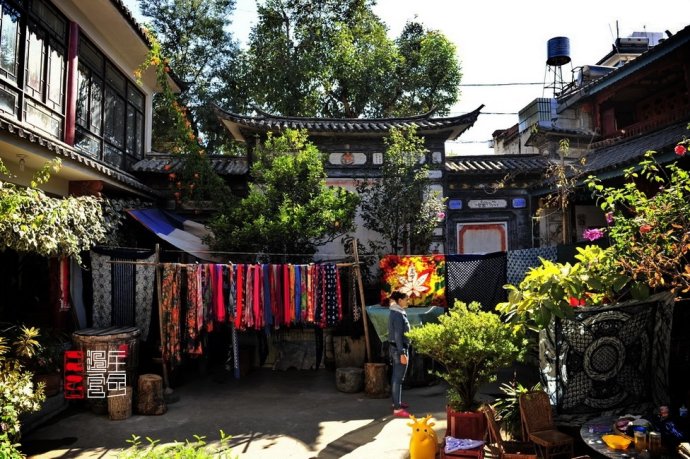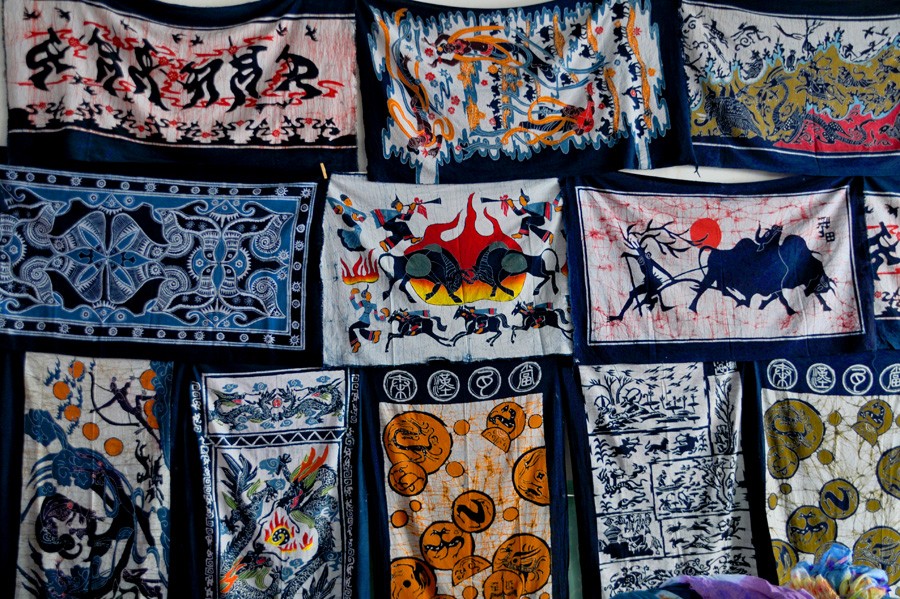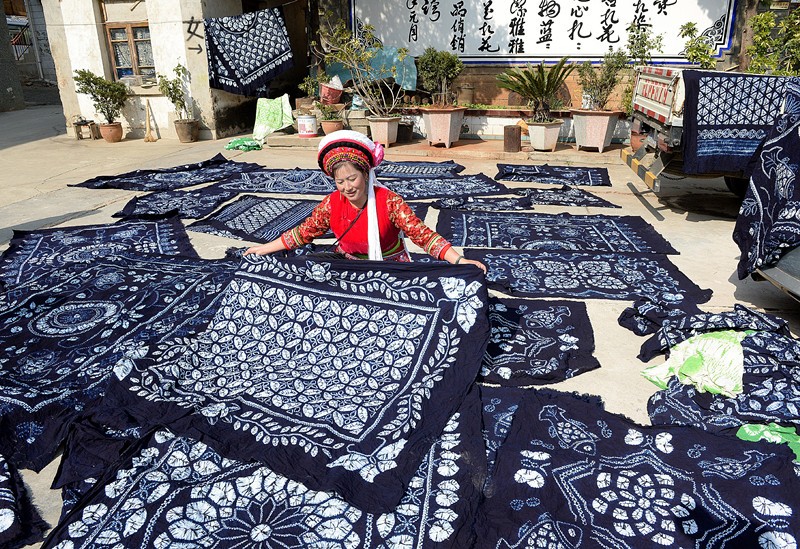
ZhouCheng tie-dye family workshop is near the Spring of Butterflies. You will learn the making process of tie-dye cloth which is one of the Bai people's traditional handcrafts.
Address: ZhouCheng village£¬XiZhou town.

Zhouchen in Dali Town has become the main producing place of the tie-dyed cloth. The tie-dyed cloth is used to make clothes, caps, bags and so on. These products are very popular among domestic and foerign visitors and are therefore exported to Japan and Southeast Asian countries.

Tie-dyed Cloth is generally called "Colorful Tied - Cloth". It was an ancient skill of dyeing originating from the interior of China. Tie-dye is typically brightly colored, patterned textile or clothing which is made from ordinary cloth, usually cotton, through a resist dyeing process known as tie-dyeing. This is the modern version of a traditional dyeing method used in many cultures in Asia and Africa.

Tie-Dye Techniques of Bai Ethnic Group
Tie-dyeing is an old Chinese textile dyeing technique. Nowadays this traditional technique is still popular in Zhoucheng Village, Dali City in Dali Bai Autonomous Prefecture and some places in Weishan Yi and Hui autonomous county. The Zhoucheng Bai Nationality tie-dyeing technique is the most famous and the area was named 'the Land for National Tie-dye' by China Culture Administration.
The tie-dyed materials are usually are white cotton cloth or a blended fabric of cotton and flax, and the dye is mainly made from indigo plants. The main tools used are jars and sticks. There are many kinds of Bai tie-dyed items, using natural patterns with lucky meanings. The finished products are aesthetically valuable and pleasing to consumers both at home and abroad. Dali Bai tie-dye shows strong folk art styles and Bai customs and taste.
The concept behind tie-dyeing is to restrict the dye from reaching certain areas of the cloth, this is achieved through the use of knots, threads, rocks, sticks and rubber bands. The color of the parts the dye reaches changes but the restricted parts stay untouched, giving a pleasant color contrast.
This method appeared in the 3rd to 4th century in China and is still used today. Bright colors, an unlimited variety of patterns and color combinations, and the simplicity of the techniques contribute to its enduring appeal.
Tie-dyeing is a time-honored handicraft of the Bai ethnic group, who mainly inhabit southwest China's Yunnan Province. To make the dye, woad leaves are collected and fermented in a pit until they are indigo in color. White cloth is tied and sewn into various patterns by hand and then dyed. After the cloth is dried and rinsed, designs of bees, butterflies, plum blossoms, fish, or insects appear with an artistic effect that cannot be achieved by painting.
However with increased industrialization, the techniques are in danger of dying out. Many problems need to be solved, such as the disappearance of the original folk features, the pollution problem and the lack of dye materials. Only by solving these problems can the development of Dali traditional tie-dyeing be promoted.
[NextPage]
How to make a Tie-dyed Cloth
The materials used are white pure cotton or white fabric of cotton and flax. The colorant of dyeing is indigo - blue extracted from dyeing -yielding herbs. The procedures include designing, painting, tying with thread, dip - dyeing, removing thread, poaching and trimming. Blue and dotted with white flowers, the cloth looks elegant and vivid. The patterns of the cloth are usually the ordinary flowers, birds, insects and fish.
The basic process is to tie up the material before applying dye in such a way that the dye only reaches part of the area to which it is applied. The boundaries of the dyed and non-dyed areas are usually rather blurred, as the dye has begun to soak into the non-tied sections.
During tie-dyeing, if a good fiber reactive dye is used, a chemical reaction takes place which permanently bonds the colorful dye to the fabric, making tie-dye safe to wash amongst other, non-tie-dyed clothes once the excess dye has been removed. As the name suggests, the fabric is tied, usually with string or rubber bands, after being folded into a particular pattern. Some areas, where the textile is tied and in inner parts of folds, do not absorb dye as readily, forming a pattern. This is known as a resist technique (the areas that are tied and the inner parts of folds resist dyeing).
Patterns are also formed by applying different color dyes to different sections of the fabric. The folded and tied textile is usually first submerged in a bath of soda ash solution for 5-30 minutes to prepare it to take the dyes, which may be applied while the fabric is still wet with this solution, or once it has dried. Soda ash, which has a high pH, prepares the cellulose fibers of the cloth for permanent chemical bonding with the acidic fiber-reactive dye used in tie-dyeing. Dye is then applied, either by submerging the cloth bundle in a bath of dye or by squirting dyes onto specific areas of the fabric.
Alternatively, the soda ash may be added directly to the dye solution rather than soaking the textile in a solution of soda ash. With this technique the dye must be used within about two hours as the soda ash within the dye solution will react with the dye. In another variation, the fabric may be dyed, and then immersed in soda ash solution.
After 12-48 hours, depending on temperature, dye, and the desired brightness of the final product, the fabric can be unwrapped and rinsed. After working out the excess dye under running water, tie-dye should be washed in a washing machine. A detergent called Synthrapol is preferred by many dyers, although any neutral detergent may be used. Excessively alkaline detergents may cause back staining.
The characteristics of the production are that the cloth is distributed to individual families in which the procedure of ty-ing with thread is done. Then they are collected back for dyeing and other procedures.
Admission Fee:¥0

You will only receive emails that you permitted upon submission and your email address will never be shared with any third parties without your express permission.
